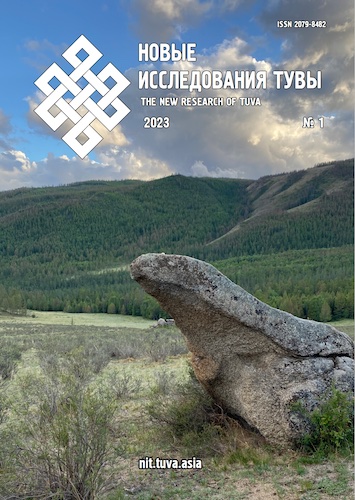Ethno-confessional neotraditionalism of the Khakas: The search for identification grounds
DOI:
https://doi.org/10.25178/nit.2023.1.7Keywords:
shamanism; Manichaeism; Christianit; Tengrianism; native land; ethno-confessional modernism; ethno-confessional traditionalism; ethno-confessional neotraditionalism; ethno-confessional identity; worldview; Khakassia; Khakas peopleAbstract
The purpose of this article is to analyze the evolution of the ethno-confessional identity of the Khakas people. In its course, on the one hand, the continuity of the shamanic foundations of faith and cult practice was preserved. This led to a more developed form of religious identity — Tengrianism. On the other hand, the Khakas joined other religious systems (for example, Manichaeism and Christianity), and this formed the well-known phenomenon of “dual faith”.
The author pays a special attention to the processes of sacralization, desacralization and resacralization of the most important value of native land. It is concluded that the doctrine of Tengrianism is being revitalized. However, this phenomenon is controversial and causes discussions not only in the academic circles, but also in the society.
In modern Tengrianism, traditionalist, modernist and neotraditionalist tendencies have appeared. Traditionalist actors, as a rule, adhere to strict observance of the dogmas of the religious doctrine and the rules of the cult practice. While comprehending the worldview of Tengrianism, modernists who mainly belong to the national intelligentsia tend to be non-confessional in the interpretation of the creed and prone to liberal forms of cult practice. Neotraditionalist actors seek to use traditional forms of ethno-confessional identity as a resource to raise the motivation of ethnophors for achieving ethnic solidarity and intensification of modernization. Unlike traditional forms of shamanism and Tengrianism, contemporary actors actively construct a new social reality using legislative practice (for example, for the protection of sacred sites), institutional forms of organization (societies, movements, actions, etc.), and, finally, science.
References
Anzhiganova, L. V. (2007) Evoliutsiia mirovozzreniia khakasov [The evolution of the worldview of the Khakas]. Abakan, Khakas Book Publishing House. 146 p. (In Russ.).
Butanaev, V. Ya. (2001) Khakasskii istoricheskii fol'klor [Khakas historical folklore]. Abakan, Publishing House of Katanov State University of Khakassia. 146 p. (In Russ.).
Butanaev, V. Ya. (2006) Traditsionnyi shamanizm Khongoraia [Traditional shamanism of Hongorai]. Abakan, Khakas Book Publishing House. 340 p. (In Russ.).
Dagylga: tuvinskie obriady osviashcheniia v XXI veke [Dagylga: Tuvan rites of consecration in the 21st century] (2021) / ed. by Ch. K. Lamazhaa and N. D. Suvandii. Kyzyl, s. n. 188 p. (In Russ. and Tuv.).
Danilova, V. S. and Kozhevnikov, N. N. (2022) Iskhodnye printsipy i osnovnye poniatiia tengrianstva [The basic principles and main concepts of Tengrianism]. In: Aiyy Tangara i kuznechnyi kul't v tengrianstve [Aiyy Tangara and the blacksmith cult in Tengrianism] : Proceedings of the 3rd All-Russian science-to-practice conference with international participation / ed. by L. V. Fedorov. Yakutsk, Dani-Almas. 176 p. Pp. 56–64. (In Russ.).
Katanov, N. F. (2004) Izbrannye trudy o Khakasii i sopredel'nykh territoriiakh [Selected works on Khakassia and adjacent territories] / comp. by S. A. Ugdyzhekov. Abakan, Publishing House of Katanov State University of Khakassia. 257 p. (In Russ.).
Kyzlasov, L. R. (2001) Sibirskoe manikheistvo [The Siberian Manichaeism]. Etnograficheskoe obozrenie, no. 5, pp. 83–90. (In Russ.).
Mainagashev, S. D. (1916) Zhertvoprinoshenie Nebu u bel'tirov [Sacrifice to the Sky among the Beltirs]. In: Sbornik Muzeia antropologii i etnografii imeni Petra Velikogo pri Imperatorskoi akademii nauk [Collection of Peter the Great Museum of Anthropology and Ethnography at the Imperial Academy of Sciences]. Petrograd, Printing House of the Imperial Academy of Sciences. Vol. 3. xvi, 212 p. Pp. 93–102. (In Russ.).
Malashin, G. V. (2011) Krasnoiarskaia (Eniseiskaia) eparkhiia RPTs. 1861–2011. Istoriko-publitsisticheskie ocherki [Krasnoyarsk (Yenisei) diocese of the Russian Orthodox Church. 1861–2011. Historical and journalistic essays]. Krasnoyarsk, Publishing House “Vostochnaia Sibir'”. 480 p. (In Russ.).
Malov, S. E. (1951) Pamiatniki drevnetiurkskoi pis'mennosti. Teksty i issledovaniia [Monuments of ancient Turkic writing. Texts and research]. Moscow ; Leningrad, Publishing House of the Academy of Science of the USSR. 451 p. (In Russ.).
Religiozno-nravstvennoe soznanie naseleniia Respubliki Khakasiia: problemy i perspektivy razvitiia [Religious and moral consciousness of the population of the Republic of Khakassia: Issues and prospects of development] (2007) / ed. by V. G. Ibragimova et al. Abakan, Publishing House of Katanov State University of Khakassia. 207 p. (In Russ.).
Smoliak, A. V. (1991) Shaman: lichnost', funktsii, mirovozzrenie (narody Nizhnego Amura) [Shaman: Personality, functions, worldview (Peoples of the Lower Amur)]. Moscow, Nauka. 276 p. (In Russ.).
Traditsionnoe mirovozzrenie khakasov: proshloe, nastoiashchee, budushchee [The traditional worldview of the Khakas: Past, present, future] (1997) : Proceedings of the International seminar “Tradition. Khakas Worldview: Past, Present, Future”, Abakan, September 25, 1997 / editorial board.: G. G. Kotozhekov (executive ed.) and others. Abakan, Khakas Book Publishing House. 113 p. (In Russ.).
Potapov, L. P. (1991) Altaiskii shamanism [Altaic shamanism]. Leningrad, Nauka, Leningradskoe otdelenie. 321 p. (In Russ.).
Ulanov, M. S. (2022) Tengrianstvo v istorii i kul’ture nomadov Tsentral’noi Azii [Tengrianism in the history and culture of the nomads of Central Asia]. New Research of Tuva, no. 3, pp. 103–115. (In Russ.). DOI: https://doi.org/10.25178/nit.2022.3.8
Published
How to Cite
For citation:
Anzhiganova L. V. Etnokonfessional’nyi neotraditsionalizm khakasov: poisk osnovanii identifikatsii [Ethno-confessional neotraditionalism of the Khakas: The search for identification grounds]. New Research of Tuva, 2023, no. 1, pp. 125‑136. (In Russ.). DOI: https://doi.org/10.25178/nit.2023.1.7
Issue
Section

This work is licensed under a Creative Commons Attribution-NonCommercial 4.0 International License.

Author(s) license holder(s) grant rights for their work to the journal (grantee of a license) under the simple non-exclusive open license in accordance with Art. 1286.1 «Open license for a research work, work of literature or fine arts», Civil Code of the Russian Federation.
New Research of Tuva publishes articles under the Creative Commons Attribution-NonCommercial license (CC BY-NC).
Since it is an open license, author(s) reserve the right to upload the article to their institutional repository, submit it to another journal (if it allows republications), or republish it on their own website (in full, or in part).
However, several conditions apply here:
a) The republished version must always contain the name(s) and affiliation(s) of the author(s), the original title and the hyperlink to the original version on the New Research of Tuva website;
b) It must be in open access, free of charge, and no category of readers must be in any way whatsoever advantaged over general readership.
c) should the contribution be submitted elsewhere by its author(s) without substantial modification (30% or more of original text unchanged), the body of the article should contain a disclaimer that the original version was published in New Research of Tuva (with a link to the respective page)
The CC-BY-NC is a non-revocable license which applies worldwide and lasts for the duration of the work’s copyright.









